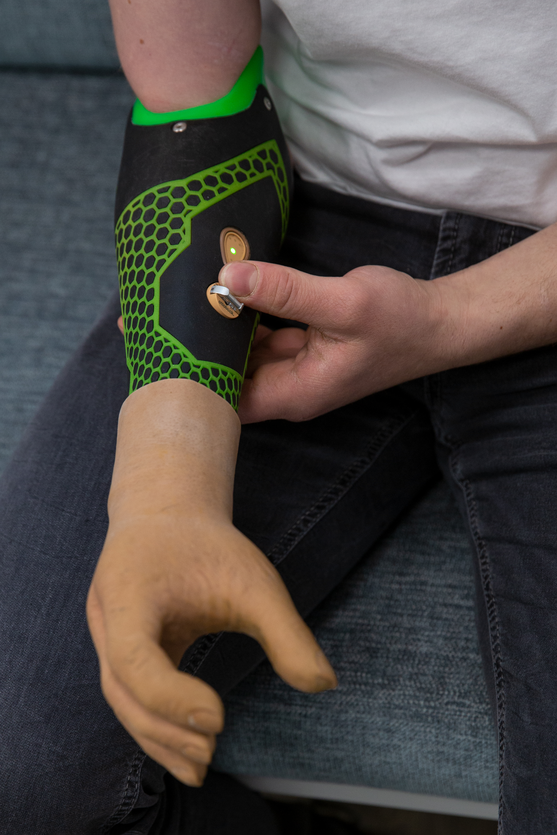Myoelectric control allows you to actively grasp objects.
We train you in the everyday use of your myoelectric arm prosthesis.
Make an appointment over the phone or send us a message!

Myoelectric arm prosthesis
Muscle-signal-driven prosthesis
A myoelectrically controlled arm prosthesis returns various natural functions to your hand. Whether you need a device that starts from your shoulder, upper arm or forearm, we provide you with a tailor-made solution.
The electronic hand of a myoelectric arm prosthesis is controlled by your muscles (= "myo"). Electrodes positioned in the prosthesis shaft record the contraction of the muscles in the residual limb and translate them into hand movements. Different grips can be used to control the hand, depending on the hand or control system. Driving a car, handwork, and much more can be taken up again with a myoelectric arm prosthesis – all that is needed is ambition and consistent training.
Here is an overview of the typical procedure for prosthesis treatment at POHLIG.
The cost of a prosthesis depends on several factors.
Shaft, control system, hand,...
Components of a myoelectric arm prosthesis
- TMR (Targeted Muscle Reinnervation)
Users who receive TMR treatment can perform hand, wrist and elbow movements simultaneously after training has been successfully completed.
- Pattern recognition system
A personalized app is used to store individual movement patterns of the prosthesis user, to which the prosthesis responds. A variety of grip patterns are possible.
- Conventional two-electrode control
Opening and closing takes place in the respective grip type using direct control. Additional hand movements are possible via switch-over signals.


An industrially manufactured prosthetic hand is located at the end of the socket. It is selected depending on the individual needs of the prosthesis wearer. We supply our patients with prosthetic hands from different manufacturers. There are two primary classifications for prosthetic hands:
- System hand
- Multi-articulating hand
System hand:
The basic unit of all myoelectric system hands is a functional grasping unit that opposes the thumb with a two-finger group (index and middle finger). The system hand performs a "pincer grip". The gripping unit is covered by a soft plastic shell in the form of a hand. This shell provides both shape and load-bearing capacity and is typically covered by prosthetic glove.
Multi-articulating hand:
Multi-articulating hands contain individual motors in all fingers that enable precise, natural grasping. The fingers or finger joints can be moved individually. In addition to the pincer grip, many other grip types can be set (cylinder grip, three-point grip, index finger, etc.). In contrast to the system hand, the thumb of a multi-articulating hand can be used in lateral and opposition positions.
All prostheses are equipped with an on/off switch. This prevents loss of power or unintentional opening of the hand (e.g. when carrying a bag).
Prosthetic hands function in different ways:
- Myoelectrically controlled prosthesis with passive rotation of the hand:
Opening and closing of the hand occurs via a muscle signal, while rotation to the desired position is performed by the users opposite hand.

- Myoelectrically controlled prosthesis with active rotation of the hand (pronation and supination):
Opening and closing, as well as rotation in both directions, are each performed via a specific muscle signal. A rotation insert is integrated into the prosthesis for this purpose.
- Myoelectrically controlled prosthesis with electrical rotation of the hand (pronation and supination):
Opening and closing of the hand occurs via a muscle signal. The electrical pronation and supination is switched by slight rotational movements of the residual limb via a rotation control.
- Myoelectrically controlled prosthesis with electrical rotation of the hand (pronation and supination) by means of four-channel control:
Opening of the hand occurs via a muscle signal. A stronger contraction results in a higher muscle signal, the system automatically switches from opening and closing to rotation (pronation and supination). A weaker contraction brings the system back to the first function. Another switching option is the so-called "co-contraction", i.e., briefly tensing both muscle groups brings the system from one function to the other.
- Pattern recognition system:
Prosthetic hands with pattern recognition have a high level of functionality (e.g. wrist rotation, wrist flexion, various grips, grip patterns, individually controllable fingers). In this case, the hand is directly controlled by the trained muscle signal (no compensatory control). The hand learns to interpret the user's individual movement patterns and assigns them to a specific prosthetic movement.

The electrically-powered gripper can be exchanged for the myoelectric hand. It works like a pair of pliers and has the shape of a hook. The gripper is intended for rough activities with high demands (e.g. agriculture, housework, manual work).

The electrodes built into the socket detect the muscle signals from the residual limb muscles. For this reason, it is important that the electrodes lie on the skin. A potentiometer amplifies the voltages of the muscles, which are in the Myo-Volt range, up to 50,000 times.

Each myoelectrically controlled prosthesis has a rechargeable battery that serves as the energy source (depending on the hand system, these are 11.1 or 7.4 volt batteries - 4.8 volts for children's hands).
In most prostheses, the battery is built into the prosthesis, so the entire prosthesis is connected to the charger for charging.
With other prostheses, the battery is in an insert frame and can be replaced. In this case, it is recommended to always keep a charged battery in reserve, as the battery may not last the entire day. For safety reasons, only the original batteries may be used.

If your prosthesis has a removeable battery, you will also receive a battery charger from us. This is connected to a 220 volt power supply. The charger must not be used to charge other batteries. Please make sure that the battery is only inserted into the charger in the correct position. Improper handling will lead to defects of the accumulator and the charger!
With the switch on the side, the charger can be set to "operation". A red signal light indicates that the battery is charging. If even a charging time of 4-5 hours does not improve the function, please contact your orthopedic technician. The charger must be secured against falling, impact or operating errors, as this can lead to defects.
For prostheses with integrated rechargeable batteries, a charging socket is located on the socket. To charge the prosthesis, simply plug the supplied cable into the charging socket. The scale shows you how far the battery is charged. Please observe the specific manufacturer's information on operating the charger.

The prosthetic glove replicates the anatomical structure of the hand and gives the prosthetic hand a natural appearance. It is available in many color variations.
Multi-articulating hands are usually worn without a glove, as gloves may cause functional restrictions.
High-tech prosthesis for farming work
You have to look twice when Wolfgang feeds his 40 cows, drives his tractor over the field, or cleans the stable. The young farmer from Bavaria wears a myoelectric arm prosthesis.
Three years ago, a tragic work accident occurred on the idyllic farm – Wolfgang’s right forearm got caught in a machine and had to be amputated immediately. After amputation, Pohlig fit Wolfgang with an individually manufactured arm prosthesis. Since then, the young farmer has continued as if nothing had ever happened. Excellent medical care, family support and support from Pohlig’s orthopedic technology has helped Wolfgang get acquainted with his new circumstances and take his life into his own hands once again.


MyoCamp
We hold a MyoCamp event for young prosthetic arm users every two years. Together with a competent team of physiotherapists and orthopedic technicians, we provide fun ways of learning how to use a myoelectric arm prosthesis.
The popular camp usually lasts several days and offers children and their parents an excellent opportunity to make new contacts or meet friends again.

Let yourself be inspired! We follow many interesting patients during their Pohlig appointment and give you personal insights.

For those who want to delve even deeper into the subject, we have a suitable video for almost every area of treatment!

Take a look behind the scenes at Pohlig and learn about different health conditions and our innovative assistive technology solutions!

Sometimes funny, sometimes explanatory, sometimes emotional - but above all always entertaining: our videos on TikTok!
As part of a trade fair presentation by our company at the DGH Congress, farmer Wolfgang demonstrates which grips he can perform with his myoelectrically controlled arm prosthesis.

Ahmed works in the office and as a cab driver. The 24-year-old was born with a malformation in his arm and therefore wears a myoelectric arm prosthesis. The artificial hand from Ottobock enables this young man to exercise various grips and live his life completely independently.
In the case of the passive arm prosthesis (also cosmetic prosthesis), external appearance is the priority.
Hand and partial hand prostheses are divided into passive, myoelectrically controlled, and work prostheses.




